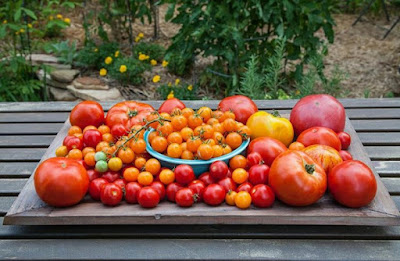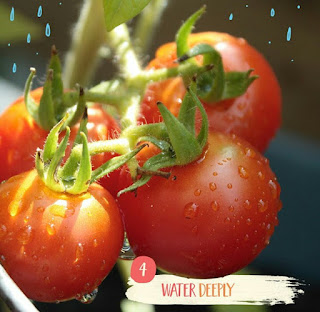Growing tomatoes easy and simple
Growing tomatoes in backyard of your garden.
When someone says you're spending too much time in garden,Tell them,''i love gardening from my head to to-ma-toes''. we"re picking up the what you're planting . :)
Happiness is a large, ripe tomato. Create your own happy place right in your backyard with these simple steps.
1.FIND A SUNNY SPOT:
- Tomatoes run on warmth; plant in late spring and early summer except in zone 10, where they are a fall and winter crop.
- Devote a prime, sunny spot to growing tomatoes. Tomatoes need at least 6 to 8 hours of sun to bring out their best flavors.
- You will need to stake, trellis, or cage most tomato plants to keep them off the ground. Decide on a support plan before you set out your plants, then add that support directly after planting.
- Give each plant enough room to grow. Space robust, long-vined, indeterminate varieties about 3 feet apart. Stockier determinate plants can be grown 2 feet apart. If growing in containers, you’ll need at least a 24-inch pot for an indeterminate variety, or an18-inch pot for a determinate variety.
- Tomatoes take up nutrients best when the soil pH ranges from 6.2 to 6.8, and they need a constant supply of major and minor plant nutrients. To provide the major nutrients, mix a continuous-release fertilizer, such as Miracle-Gro Shake ‘N Feed, into the soil as you prepare the planting holes, following the rates given on the fertilizer label.
- At the same time, mix in 3 to 4 inches of compost, which will provide minor nutrients and help hold moisture and fertilizer in the soil until it is needed by the plants.
- To grow a really strong tomato plant, we recommend burying two-thirds of the stem when planting. This crucial step will allow the plant to sprout roots along the buried stem, so your plant will be stronger and better able to find water in a drought. Please note that this deep-planting method only works with tomatoes (and tomatillos), not other veggies.
- Immediately after planting, water seedlings and add a liquid plant food, such as Bonnie Herb, Vegetable & Flower Plant Food , to give them a good start. Feed with liquid plant food every couple of weeks during the growing season.
2.ADD COMPOST:
Adding up compost gives the plant to add more vitamins and minerals and give good growth to plant .thier you have to mix several varietes of mixers to get compost ready .
3.PLANT DEEPLY:
Planting a tomato plant deeply into the soil gives a good growth to plant.The plant take some to adjust but it will show good growth . soil should be wet and clean to grow plant easy and healthy daily water the plant and soil .
4:WATER DEEPLY:
Immediately water plants after planting...
How to Troubleshoot Tomato Problems
- As summer heats up, some tomatoes have trouble setting fruit. Be patient, and you will start seeing little green tomatoes again when nights begin cooling down. Meanwhile, promptly harvest ripe tomatoes to relieve stressed plants of their heavy burden. If you live in an area in which summertime temperatures are typically in the 90s, be sure to choose some heat-tolerant tomato varieties, bred for their ability to set fruit under high temperatures.
- Humid weather creates ideal conditions for fungal diseases like early blight, which causes dark spots to first form on lower leaves. Be sure to remove any unhealthy looking or diseased leaves throughout the season. Late blight is a more devastating disease that kills plants quickly; the only way to control it is to protect
against it by spraying the leaves with an approved fungicide such as chlorothalonil or copper, and to keep the garden clean of plant debris.
Love seeing Flowers on tomato plants - You’ll also want to be on the lookout for pests. In mid-summer, for example, big green caterpillars called tomato hornworms eat tomato foliage and sometimes damage fruits. One or two hornworms can strip a plant leafless in short order! Deal with pests as soon as you spot them.
- By late summer, plants that began producing early in the season will show signs of exhaustion. With just a little effort, you can rescue those sad tomato plants by pruning away withered leaves and branches. Then follow up with liquid plant food and treatments for leaf diseases or insects, if needed.
How to Harvest and Store Tomatoes
- As tomatoes begin to ripen, their color changes from vibrant medium-green to a lighter shade, with faint pink or yellow blushing. These “breakers,” or mature green tomatoes, can be chopped into salsas, pickled, or pan-fried into a crispy appetizer. Yet tomato flavors become much more complex as the fruits ripen, so you have good reason to wait. The exact signs of ripeness vary with variety, but in general, perfectly ripe tomatoes show deep color yet still feel firm when gently squeezed.
- Store picked tomatoes at room temperature indoors, or in a shady place outside. Never refrigerate tomatoes, because temperatures below 55° cause the precious flavor compounds to break down.
- Bumper crops can be frozen, canned, or dried for future use.

Pruning tomatoes .
Next article.







Nice
ReplyDelete